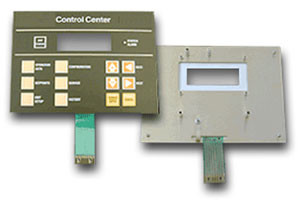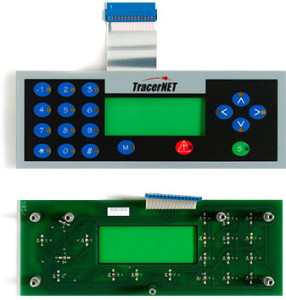A Definition of Back Panels for Membrane Switches
Membrane switches are momentary electrical on/off switches for activating and deactivating a circuit. Many membrane switches require

Types of Back Panels for Membrane Switches
The most commonly used material for back panels is aluminum, which can be supplied with a variety of hardware installed. Aluminum back panels for membrane switches can be bare, iridited, alodined, painted, or anodized. Other types of back panels for membrane switches include plastic injected molded cases/front cover, other metal panels, circuit board materials, stainless steel, acrylic, polycarbonate, and ABS.
- Plastic injected molded cases – These back panels for membrane switches have a molded cavity that receives the membrane switch and allows it to be flush with the case surface. Common in the medical industry, plastic injected molded cases appear as one piece because they have a color and texture that matches the membrane switch. In the case of plastic injected molded cases, the parting lines, bosses, and injector pin marks must be avoided in all switch button locations in order to prevent switch actuation issues.
- Metal back panels for membrane switches – Metal back panels for membrane switches are popular for industrial controls. Typically made of aluminum or steel, these back panels commonly are coated with a protective finish to prevent corrosion. Black anodized aluminum back panels are very common for membrane switches, as they may be any shape, size, or thickness that the product requires.
- Circuit board back panels – When printed circuit boards (PCBs) lack circuitry, they may be used as back panels for membrane switches. This allows for similar hardware to be installed as metal panels while allowing the panel to be lighter and nonconductive. Circuit board back panels are used most often in portable equipment that needs to be lighter, such as radio controllers and phone systems.
Manufacturing Considerations for Back Panels for Membrane Switches
Leading manufacturers of membrane switches fabricate back panels

It is critical that the subpanel have different mechanical dimensions to allow for assembly tolerances. To ensure that the subpanel is not visible after assembly, it should be .020″ smaller than the membrane switch in both height and width, all cutouts and holes should be .030″ larger, and cutouts behind windows should be .060″ larger than the window. Leading membrane switch fabricators are able to include special cutout shapes or leave subpanel edges completely free of tool marks, because they use CNC milling and routing equipment for machining special shapes, contours, beveled edges, and more that deliver the desired aesthetics to help differentiate equipment from the competition.
Final Thoughts on Back Panels for Membrane Switches
Every component of your membrane switch assembly should meet and exceed its unique application requirements, including the back panel. Various features of the back panel may be just as important as the aesthetics of the keypad when considering the user experience.

